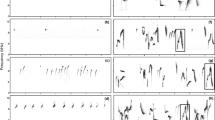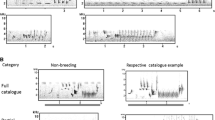Abstract
At least 44 different song types were recorded in a population of Coal Tits at Klaebu in central Norway. Each male sang up to 14 different types. In testing the Beau Geste hypothesis the following predictions were made: (1) Territorial males tend to change song type when moving from one song post to another. (2) The tendency to change song type when moving from one song post to another increases with the distance between the song posts. (3) Territory holders prefer inconspicuous song posts that reduce the chances of being instantly detected by possible intruders and prospectors. However, none of these predictions were confirmed by the data analyses. The singing behaviour of the Coal Tit does therefore not support the Beau Geste hypothesis.
Zusammenfassung
In einer Population der Tannenmeise bei Klaebu, Mittelnorwegen, wurden mindestens 44 unterschiedliche Gesangstypen registriert. Einzelne Männchen sangen bis zu 14 Typen. Um die Beau-Geste-Hypothese (ein Sänger täuscht durch verschiedenen Gesangstypen die Anwesenheit mehrerer Individuen vor) zu testen, wurden folgende Annahmen geprüft: (1) Territoriale Männchen neigen dazu, ihren Gesangstyp zu ändern, wenn sie die Singwarte wechseln. (2) Die Tendenz, zwischen Gesangstypen zu wechseln, ist bei Männchen am größten, die während einer Gesangsphase mehr als eine Singwarte benutzen. (3) Territoriale Männchen benützen unauffällige Singwarten, um nicht so schnell von möglichen Eindringlingen oder reviersuchenden Artgenossen entdeckt zu werden. Die Analyse der Daten ergab jedoch für keine dieser Annahmen eine Bestätigung. Somit unterstützt das Verhalten singender Tannenmeisen die Hypothese nicht.
Similar content being viewed by others
Literature
Baker, M. C. (1988): Sexual selection and size repertoire in songbirds. Acta XIX Congr. Int. Orn. I: 1358–1365. Ottawa.
Ditto,T. K. Bjerke, H. Lampe &Y. Espmark (1986): Sexual response of female Great Tits to variation in size of males' song repertoires. Am. Nat. 128: 491–498.
Björklund, M., B. Westman &K. Allander (1989): Song in Swedish Great Tits: intra- or intersexual communication? Behaviour 111: 257–269.
Catchpole, C. K. (1989): Responses of male Sedge Warbler to playback of different repertoire sizes. Anim. Behav. 37: 1046–1047.
Ditto.,J. Dittami &B. Leisler (1984): Differential responses to male song repertoires in female songbirds implanted with oestradiol. Nature 312: 563–564.
Ditto. &B. Leisler (1989): Variation in the song of the Aquatic WarblerAcrocephalus paludicola in response to playback of different song structures. Behaviour 87: 125–138.
Dawson, S. M., &P. F. Jenkins (1983): Chaffinch song repertoires and the Beau Geste hypothesis. Behaviour 87: 256–269.
Goller, F. (1987). Der Gesang der Tannenmeise (Parus ater): Beschreibung und kommunikative Funktion. J. Orn. 128: 291–310.
Haftorn, S. (1990): Sangvariasjoner hos svartmeisParus ater. Proc. Sixth Nordic Congr. Orn. 1987, Fauna norv., Ser. C, Cinclus Suppl. 1: 52. (In Norwegian.)
Järvi, T., T. Radesäter &S. Jakobsson (1980): The song of the Willow WarblerPhylloscopus trochilus with special reference to singing behaviour in agonistic situations. Ornis Scand. 11: 236–242.
Kramer, H. G., &R. E. Lemon (1983): Dynamics of territorial singing between neighbouring Song SparrowsMelospiza melodia. Behaviour 85: 198–223.
Krebs, J. R. (1977): The significance of song repertoires: the Beau Geste hypothesis. Anim. Behav. 25: 475–478.
Ditto,R. Ashcroft &M. Webber (1978): Song repertoires and territory defence in the Great Tit. Nature 271: 539–542.
Lambrechts, &A. A. Dhondt (1988): The anti-exhaustion hypothesis: a new hypothesis to explain song performance and song switching in the great tit. Anim. Behav. 36:327–334.
Morton, E. S. (1982): Grading, discreteness, redundancy, and motivation-structural rules. In:D. E. Kroodsma &E. H. Miller, Acoustic communication in birds. 1: 183–212. N. Y.
Platt, M. E., &M. S. Ficken (1987): Organization of singing in House Wrens. J. Field. Orn. 58: 190–197.
Schroeder, D. J., &R. H. Wiley (1983): Communication with repertoires of song themes in Tufted Titmice. Anim. Behav. 31: 1128–1138.
Searcy, W. A. (1983): Response to multiple song in male Song Sparrows and Field Sparrows. Anim. Behav. 31: 948–949.
Slater, P. J. B. (1978): Beau Geste has problems. Anim. Behav. 26: 304.
Ditto (1981): Chaffinch song repertoires: observations, experiments and a discussion of their significance. Z. Tierpsychol. 56: 1–24.
Thielcke, G. (1970). Die sozialen Funktion der Vogelstimmen. Vogelwarte 25: 204–229.
Ders. (1973). Uniformierung des Gesanges der Tannenmeise (Parus ater) durch Lernen. J. Orn. 114: 443–454.
Wittenberger, J. F. (1983). A contextual analysis of two song variants in the Bobolink. Condor 85: 172–184.
Yasukawa, K. (1981). Song repertoires in the Red-winged Blackbird (Agelaius phoeniceus): a test of the Beau Geste hypothesis. Anim. Behav. 29: 114–125.
Ders. &W. A. Searcy (1985). Song repertoires and density assessment in Red-winged BlackbirdsAgelaius phoeniceus: further tests of the Beau-Geste hypothesis. Behav. Ecol. and Sociobiol. 16: 171–176.
Author information
Authors and Affiliations
Rights and permissions
About this article
Cite this article
Haftorn, S. Coal TitParus ater song repertoires and the Beau Geste hypothesis. J Ornithol 136, 279–283 (1995). https://doi.org/10.1007/BF01651295
Published:
Issue Date:
DOI: https://doi.org/10.1007/BF01651295




